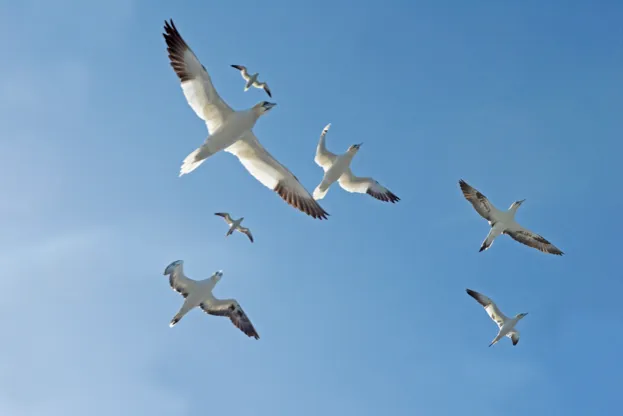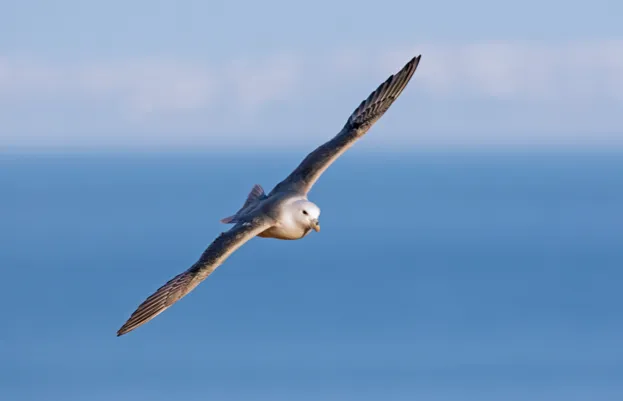Look out for bottlenose dolphins © Tim Stenton / Barcroft Media / Getty
To help make the most of your time on board, we asked Lucy Babey, head of science and conservation at marine life conservation charity ORCA, for her top wildlife-watching tips:
1. Plan in advance
Any time you are heading out to sea, make sure you do some research in advance to get an idea of what animals might be seen. It will help you identify which species you are seeing, as well as giving you a clue as to where you might spot different species and what to look out for. Be sure to keep an eye on the time of year as well - many species migrate thousands of miles and there's nothing worse than finding out your favourite animal headed to the Arctic the week before you arrived!
2. Pick your crossing
Some routes take a very different path even if they are heading to the same destination, and so the wildlife can vary dramatically. Where possible, trips that have a lot of daytime sailing will be an obvious choice, but if you are on longer crossings try and select trips where you can be on deck at first light - it's often one of the best times of day to see many species.
3. Make sure you have everything you need
Binoculars are also advisable – on larger ferries the horizon can be many miles away so there's a limit to what you will see with the naked eye. For keen photographers, a telephoto lens (something in the 200mm-300mm range) will maximise your chance of capturing that perfect shot.

Gannets are a common sighting from ferries © David Tipling / Barcroft Media / Getty
4. Work as a team
The more eyes you have on the water, the more chance you have of spotting something. Roping in your travelling companions is a must, but also remember that many wildlife enthusiasts love to travel on ferries across the UK throughout the year. If you see other passengers with binoculars or cameras, why not strike up a conversation and see if you can work together to maximise your chance of spotting some of the more elusive animals?
5. Perseverance is key
It may sound obvious, but the more time you spend watching out for wildlife, the more animals you are going to see. Everyone who has spent time at sea has seen disappointed passengers come up on deck late morning only to find out they missed an amazing killer whale encounter or a sighting of a rare bird, so make sure you aren't one of those people and put the hours in. It will pay off in the long run!

Fulmars are another bird species to look out for © Arterra / UIG / Getty
Get on board and get involved
Brittany Ferries recommend that sightseers set sail in the summer – on many sailings participants will be guided by an expert, making it more likely to spot sea creature movement. Brittany Ferries also team up with ORCA each summer to supply special sea safaris on their crossings to Spain. All their Spanish routes pass through the Bay of Biscay, an ideal spot to see a variety of sea creatures whilst sailing.
It is possible to see lots of wildlife when travelling with Caledonian MacBrayne, and they have appointed a full time ORCA wildlife officer to help educate crew and passengers about marine life across the west coast. Passengers have the chance to see a range of animals including otters, eagles, whales and dolphins. Last year's OceanWatch saw 302 sightings of marine mammals off the west coast. Common dolphins were the most abundant species spotted across the Mallaig to the Small Isles, Oban to Colonsay and Oban to Coll, Tiree and Barra routes, followed by harbour porpoise, grey seals and minke whales.
DFDS is funding the appointment of two Wildlife Officers on board cruise ferry King Seaways so customers can learn about the marine wildlife of the North Sea and participate in fun activities and deck watches. Common wildlife to spot en route includes dolphins, harbour porpoise, and a variety of sea birds, plus even occasionally minke whales. Customers can either book the dedicated Wildlife Watching mini cruise or just join in the activities for free. The wildlife watching activities run on board the King Seaways on routes from Newcastle to Amsterdam between late March and mid-September.
Irish Ferries facilitates a long-term survey of whales, dolphins and porpoises run by the Irish Whale and Dolphin Group (IWDG). Every month, spotters from the IWDG conduct surveys from on-board the Ulysses and the Isle of Inishmore. Anyone travelling on the ships can look out for dolphins leaping out of the water, or even riding the ship’s bow wave, whilst possible sightings also include harbour porpoises and the rare Minke whales.
The Isles of Scilly Steamship Group’s Scillonian III route is a hot spot for marine wildlife, and offers regular sightings of seabirds, sunfish, dolphins, seals and, on the odd occasion, pods of basking sharks and even Minke Whales have been spotted.
MBNA Thames Clippers have teamed up with ZSL to get passengers Wildlife Spotting in the Thames! Download their activity sheet and see how much you can spot.
Minke whales and grey seals have been spotted by a number of Isle of Man Steam Packet Company passengers, which goes to prove the Irish Sea is no stranger to marine life. The company has long supported surveys of marine life and is proud to have been associated with OCRA OceanWatch and Manx Whale and Dolphin Watch.
P&O Ferries get involved with ORCA OceanWatch each year and they encourage their passengers to watch out for wildlife year round.
Red Funnel Ferries support ORCA and say that Southampton water at low tide is a great spot for bird watchers and seals and dolphins can occasionally be seen in the Solent.
Stena Line say passengers travelling on the North Sea and on the Irish Sea may catch a glimpse of the friendly dolphins skipping alongside the ferry.
Wightlink regularly host ORCA spotters on board their ships, and have done since 2015. They recommend the coasts of Yarmouth, the Isle of Wight and even the busy Portsmouth Harbour as great places to spot dolphins, though whales are rare.

